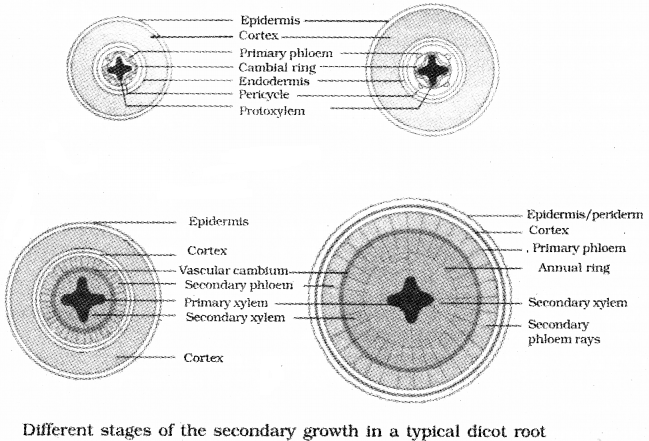Kerala Plus One Botany Notes Chapter 4 Anatomy of Flowering Plants
What is plant anatomy?
It is the study of internal structure of plants. In angiosperms, the monocots and dicots are anatomically different.
The Tissues:
Group of cells having a common origin and function.
Do you agree that all tissue in plants are capable of division?
Some tissues are capable of division they are called meristemetic tissues, while others are capable of divisor , they are called permanent tissues.
Meristemetic Tissue:
They are found in specific region of plant i.e. growing region the tips of roots and shoots
Classification based on the position:
- Apical meristem
- Inter calary meristem
- Lateral meristem.
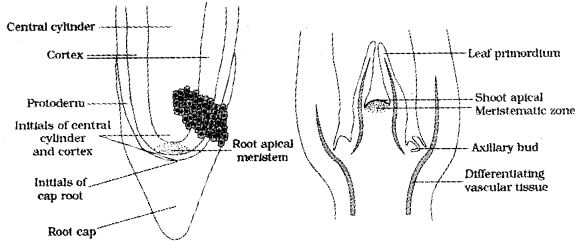
1. Apical meristem:
In root it is situated at the tip while in shoot it lies in the distant most region of the stem axis. The portion of shoot apical meristem i.e axillary bud present in the axils of leaves forms branch or a flower.
2. Intercalary meristem:
It occurs between mature tissues or base of internode of grasses. The above two meristems are primary meristems because they appear early in the life of a plant.
Grasses in an area are cut and removed by cows, after few days regeneration occurs and new grasses are formed. Why?
Due to the activity of intercalary meristem.
3. Secondary or lateral meristem:
It occurs in the mature regions of roots and shoots of plants particularly in woody axis. Eg-Fascicular vascular cambium, interfascicular cambium and cork-cambium.
For example: In some woody species after few years thickness of plant body increases from 5 inch diameter to 10 inch diameter. Why this happens?
Due to the activity of lateral meristem
What is permanent tissues?
Meristems structurally and functionally specialised and lose the ability to divide. Such cells are termed as permanent tissues.
Permanent Tissues:
Classification:
- Simple tissues: They are made up of similar kind of cells
- Complex tissues: They are made up of different kind of cells
Simple Tissue:
1. Parenchyma:
- They are isodiametric, spherical, oval, round, polygonal or elongated in shape.
- Their walls are thin and made up of cellulose.
- They may either be closely packed or have small intercellular spaces.
Functions:
Photosynthesis, storage and secretion.
2. Collenchyma:
- It occurs just below the epidermal layer.
- Cells of this tissue are thickened at the corners due to a deposition of cellulose, hemicellulose and pectin.
- Collenchymatous ceils may be oval, spherical or polygonal and contain chloroplasts.
- Intercellular spaces are absent.
Function:
Mechanical support.

3. Sclerenchyma:
- They are thick, dead and lignified with few or numerous pits.
- They are classified into fibres and sclereids.
- The fibres are thick-walled, elongated and pointed cells occuring in groups.
Function:
Mechanical support to organs.
Structure and position of sclereids in plants:
They are spherical, oval or cylindrical, highly thickened dead cells with very narrow cavities (lumen). These are found in the fruit walls of nuts; pulp of fruits like guava, pear and sapota; seed coats of legumes and leaves of tea.
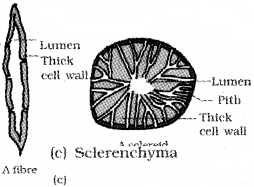
Complex Tissues:
Xylem and phloem are considered as complex tissues in plants
Xylem:
- It conducts water and minerals from roots to the stem and leaves.
- It also provides mechanical strength to the plant parts.
- Gymnosperms lack vessels in their xylem.
- It is composed of four different kinds of elements
Tracheids, vessels, xylem fibres and xylem parenchyma.
1. Tracheids:
They are dead and without protoplasm.They are elongated or tube like cells with thick and lignified walls and tapering ends. In flowering plants, tracheids and vessels are the main water transporting elements.
2. Vessel:
It is a long cylindrical tube-like structure having lignified walls and a large central cavity. They are devoid of protoplasm and interconnected by perforations in their common walls. The presence of vessels is a characteristic feature of angiosperms.
3. Xylem fibres:
They have highly thickened walls and are dead. These may either be septate or aseptate.
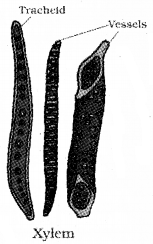
4. Xylem parenchyma”
- They are cellulosic, living and thin-walled.
- They store food materials in the form of starch or fat, and other substances like tannins.
- Radial conduction of water takes place by the ray parenchymatous cells.
- Primary xylem is of two types – protoxylem and metaxylem. The first formed primary xylem elements are called protoxylem and the later formed primary xylem is called metaxylem.
Difference between endarch and exarch condition:
In stems, the protoxylem lies towards the centre (pith) and the metaxylem lies towards the periphery of the organ. It is called endarch. In roots, the protoxylem lies towards periphery and metaxylem lies towards the centre.lt is called exarch.
Phloem:
It transports food materials, usually from leaves to other parts of the plant. Phloem in angiosperms is composed of
| Sieve tube elements, companion cells, phloem parenchyma and phloem fibres. |
Gymnosperms have albuminous cells and sieve cells. They lack sieve tubes and companion cells.
1. Sieve tube elements:
- They are also long, tube-like structures.
- Their end walls are perforated to form the sieve plates.
- A mature sieve element have a large vacuole but lacks a nucleus.
- The functions of sieve tubes are controlled by the nucleus of companion cells.

2. Companion cells:
- They are parenchymatous cells closely associated with sieve tube elements.
- The sieve tube elements and companion cells are connected by pit fields.
- The companion cells help in maintaining the pressure gradient in the sieve tubes.
3. Phloem Parenchyma:
- It consist of cylindrical cells with dense cytoplasm and nucleus.
- The cell wall is composed of cellulose and has pits through which plasmodesmata passes.
- The phloem parenchyma stores food material and other substances like resins, latex and mucilage. Phloem parenchyma is absent in monocots.
4. Phloem fibres (bast fibres):
- They are elongated, unbranched, needle like sclerenchymatous cells.
- At maturity, these fibres lose their protoplasm and become dead.
- These are generally absent in the primary phloem but are found in the secondary phloem.
| Commercially important Phloem fibres are jute, flax and hemp |
| The first formed primary phloem is called as protophloem |
| later formed phloem has bigger sieve tubes and is called as metaphloem |
The Tissue System:
Based on the of their structure and location, there are three types of tissue systems.
- Epidermal tissue system
- The ground or fundamental tissue system
- Vascular or conducting tissue system.

1. Epidermal tissue system:
Stomata are present in the epidermis of leaves regulate the process of transpiration and gaseous exchange.
Shape of guard cell in dicot and monocot:
In dicot, it consist of two bean-shaped cells known as guard cells. In grasses(monocot), the guard cells are dumb bell shaped.
- The outer walls of guard cells are thin and the inner walls are thickened.
- The guard cells possess chloroplasts and regulate the opening and closing of stomata.
- Guard cells are surrounded by specialised cells they are known as subsidiary cells.
What is stomatal apparatus?
The stomatal aperture, guard cells and the surrounding subsidiary cells are together called stomatal apparatus.
- The root hairs help to absorb water and minerals from the soil.
- On the stem the epidermal hairs are called trichomes.
- They have secretory function.
- The trichomes also help to prevent water loss due to transpiration.
2. The Ground Tissue System:
- It includes parenchyma, collenchyma and sclerenchyma.
- Parenchymatous cells are usually present in cortex, pericycle, pith and medullary rays in the primary stems and roots.
- In leaves, the ground tissues are thin-walled chloroplast containing cells called mesophyll.
3. The Vascular Tissue System:
The vascular system consists of phloem and xylem.
Different type bundles:
1. Open vascular bundles:
In dicot stems, Cambium is’present between phloem and xylem.
2. Closed vascular bundle:
In the monocot, the vascular bundles have no cambium present in them. Hence they do not form secondary tissues .

3. Radial bundle:
In roots, xylem and phloem are arranged in an alternate manner on different radii.
4. Conjoint bundle:
In stems and leaves, the xylem and phloem are situated at the same radius of vascular bundles. In this phloem located on the outer side of xylem.
Anatomy Of Dicotyledonous And Monocotyledonous Plants:
Dicotyledonous Root (eg sunflower root):
Salient features:
- The outermost layer is epidermis which is unicellular in root hairs.
- Lower layer is cortex consists of parenchyma cells with intercellular spaces.
- The innermost layer of the cortex is called endodermis.
- It comprises a single layer of barrel-shaped cells without any intercellular spaces
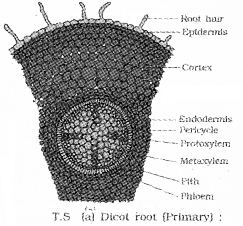
Chemical substance in endodermal wall:
- Its tangential and radial walls have a deposition of water impermeable waxy material-suberin-in the form of casparian strips.
- Next to endodermis is thick walled pericycle. From thisjateral roots and vascular cambium during the secondary growth originates.
- The pith is small.
- Conjuctive tissues are the parenchymatous cells which lie between the xylem and phloem
- Usually two to four xylem and phloem patches. Later, a cambium ring develops between the xylem and phloem.
- Stele is the tissues on the inner side of the endodermis such as pericycle, vascular bundles and pith.
Monocotyledonous Root:
The anatomy of the monocot root is similar to the dicot root in many respects.
Some specialities are given below:
- It has more than six (polyarch) xylem bundles .
- Pith is large and well developed.
Secondary thickening is most common in dicot plants:
Cambium is present only in dicot plant, it is absent in monocots, so Monocotyledonous roots do not undergo any secondary growth.
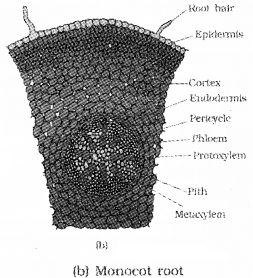
Dicotyledonous Stem:
Salient features:
- The outermost protective layer of the stem is epidermis.lt is covered by a thin layer of cuticle.
- Epidermis consist of trichomes and stomata.
- Cortex lie between epidermis and pericycle. It consists of outer hypodermis, having collenchymatous cells which provide mechanical strength.
- Thin walled parenchymatous cells seen below hypodermis.
- The innermost layer of the cortex is called the endodermis. It consists of starch grains called as the starch sheath. Inner to endodermis is Pericycle.
- Vascular bundles are arranged in ring It consist of xylem and phloem. Cambium lie between these two.
- Semi-lunar patches of sclerenchyma occur at the outer part of the phloem.
- Vascular bundle is conjoint, open, and endarch.
- Pith is seen at the central part of the stem.
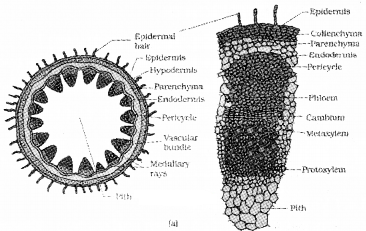
Monocotyledonous Stem Salient features:
- It consist of sclerenchymatous hypodermis and large number of scattered vascular bundles.
- It is surrounded by a sclerenchymatous bundle sheath
- Vascular bundles are conjoint and closed.
- Peripheral vascular bundles are smaller than centrally located ones.
- The phloem parenchyma is absent and water- containing cavities are present within the vascular bundles.

Dorsiventral (Dicotyledonous) Leaf:
Salient features:
- The dorsiventral leaf shows three main parts, namely, epidermis- upper syrface (adaxial epidermis) and lower surface (abaxial epidermis -bears more stomata),
- Mesophyll.- possesses chloroplasts (It has two types of cells palisade parenchyma and spongy parenchyma) and vascular system.
- Vascular system is seen in midrib & viens.
- The vascular bundles are surrounded by a layer of thick walled bundle sheath cells.
- The veins vary in thickness in the reticulate venation of the dicot leaves.
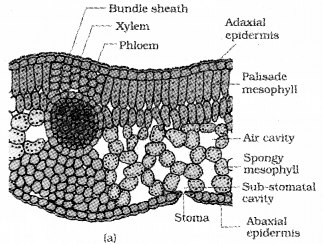
Isobilateral (Monocotyledonous) Leaf:
The vertical section of isobilateral leaf is similar to that of the dorsiventral leaf It shows some differences.
Salient features:
- It has stomata on both the surfaces of the epidermis
- Mesophyll is not differentiated into palisade and spongy parenchyma.
- The position and function of Bulliform cells: In grasses, upper epidermal cells have specialised colourless cells .they are called bulliform cells. It helps in rolling and unrolling of lamina. When they are flaccid due to water stress, they make the leaves curl inwards to minimise water loss. .
- Venation in monocot leaves is parallel.
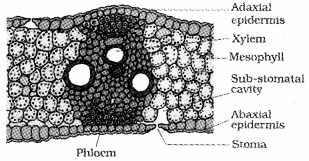
Secondary Growth:
What you mean by secondary growth?
Dicotyledonous plants shows secondary growth .i.e it increases the girth of plant body. The tissues involved in secondary growth are lateral meristems eg: vascular cambium and cork cambium
Vascular Cambium:
It is seen in between xylem and pholem. it forms a complete ring.
Formation of cambial ring:
Intra fascicular and inter fascicular cambium- Difference:
In dicot stems, cambium present between primary xylem and primary phloem is the intrafascicular cambium. The medullary cells seen in between xylem & phloem become meristematic and forms interfascicular cambium. Thus, a continuous ring of cambium is formed.
Activity of the cambial ring:
The cambial ring cut off new cells towards the inner (secondary xylem) and the outer sides( secondary phloem).
How can you analyse Canbium is more active towards inner side than outer side?
The cambium is more active on the inner side than on the outer, as a result amount of secondary xylem produced is more than secondary phloem. The primary and secondary phloems get gradually crushed due to the continued formation and accumulation of secondary xylem.
At some places, the cambium forms a narrow band of parenchyma, which passes through the secondary xylem and the secondary phloem are called the secondary medullary rays.
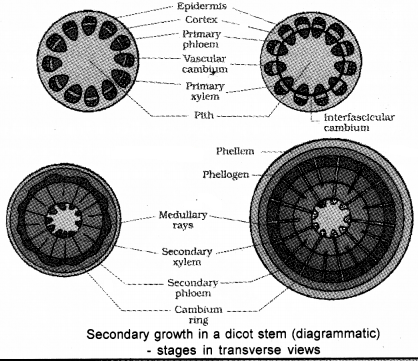
Spring wood and autumn wood:
Spring wood or early wood:
In the spring season, cambium is very active and produces a large number of xylem elements having vessels with wider cavities.This wood is called spring wood.
Autumn wood or late wood:
In winter, the cambium is less active and forms fewer xylem elements that have narrow vessels, This wood is called autumn wood. The spring wood is lighter and autumn wood is darker.
Annual ring in the calculation of age of tree:
The spring wood and autumn wood that appear as alternate concentric rings, constitute an annual ring. Age of tree can be calculate by counting the number of annual rings.
Heartwood – Durable wood?
1. The inner most layers of the stem consist of secondary xylem is dark brown due to deposition of organic compounds like tannins, resins, oils, gums, aromatic substances and essential oils.
2. It is resistant to the attack of microorganisms. This type of wood is called heartwood.
Sap wood:
The outer part of wood is light coloured, functional and and conduct water and minerals . This type of wood is called sap wood.
Cork Cambium:
Due to the activity of vascular cambium, girth of the stem increases. This results the breakdown of outer cortical and epidermis layers .So the new protective tissues are formed by another meristematic tissue called cork cambium or phellogen
Activity of cort cambium & phellogen:
Phellogen cuts off cells on both sides. The outer cells differentiate into cork or phellem while the inner cells differentiate into secondary cortex or phelloderm.
Feature of secondary tissues of phellogen and constituents of Periderm:
The cork is impervious to water due to suberin deposition in the cell wall. The cells of secondary cortex are parenchymatous. Phellogen, phellem, and phelloderm are together known as periderm.
Bark:
It is found exterior to the vascular cambium, including secondary phloem. Bark that is formed early in the season is called early or soft bark. Towards the end of the season late or hard bark is formed.
Lenticels and function:
At certain regions, the phellogen cut off closely arranged parenchymatous cells on the outer side instead of cork cells. These cells rupture the epidermis, and forms openings called lenticels. It helps in the exchange of gases between the outer atmosphere and the internal tissue of the stem.
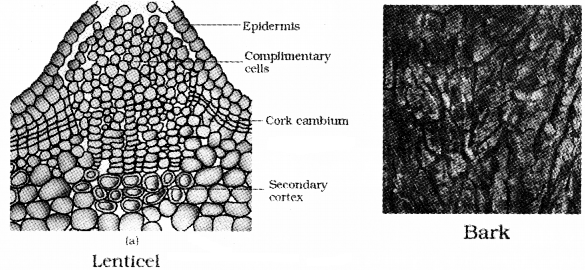
Secondary Growth in Roots:
Can you think of formation of vascular cambium is completely secondary in origin?
In the dicot root, the vascular cambium is completely secondary in origin. lt occurs in the later stages of growth. It originates from the tissue located just below the phloem bundles and a portion of pericycle tissue, opposite to protoxylem forming a complete and continuous wavy ring, which later becomes circular.
Secondary growth also occurs in stems and roots ofgymnosperms. But secondary growth does not occur in monocotyledons.
